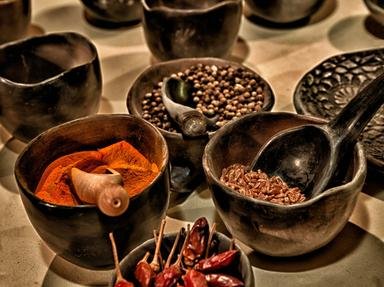Quiz Answer Key and Fun Facts
1. This common herb, used often in Latin and Mediterranean cuisine, is a very controversial herb. While the majority of the world will eat this herb, a minority finds it so awful, they describe it to taste like soap, and smell like bugs (Julia Child even told Larry King that she hated the herb so much she would pick it out and throw it on the floor). This is not too appetizing of a description, but, chemically speaking, it makes perfect sense. Which herb smells like creepy crawlies and tastes like a bar of Irish Spring?
2. I like to add a bay leaf or two to quite a number of dishes. It adds a nice flavor to chili, goes well in chowders, and adds a bit of depth of flavor to many kinds of sauces. However, when I finish cooking, I remove the bay leaf before serving. Why is it a wise idea to remove the bay leaves from a dish before serving?
3. This herb, which is most commonly used to make pesto, is very versatile. Even the seeds can be used. Some species of this herb, when their seeds are soaked in water, they become gelatinous, and, in this form, are used in many popular Asian desserts and beverages. One of these drinks is faluda. Which herb can be formed into a gel to make certain drinks?
4. When one goes to a local Japanese restaurant and orders sushi, they are often given a small plate of garnishes for the sushi. One of these spicy garnishes is known as wasabi. Wasabi is known for its spice that will clear the sinuses of just about anybody. To make this spicy paste, one grinds the wasabi root, which then becomes a paste. But wait, if you are in the United States and decide to eat at a small sushi restaurant, and order wasabi, is it usually actually from the wasabi plant?
5. If you have ever had a maple syrup substitute, you have no doubt eaten a mixture that contains the seeds of a certain herb. The leaves of the herb are often used as a vegetable, and eaten more as a lettuce in a salad than a flavoring herb. Which maple-scented herb is this?
6. There is an herb that is often used in soups, salads and omelets, mostly in France. The herb is related to parsley, and is sometimes called "gourmet's parsley". It also has a slight licorice taste to it. Which mild herb is this?
7. I typically use this herb as a flavoring agent for soups and meats (I love herbs, and liberally cover my foods with them), but they are much more versatile than that. In fact, a popular soft-drink of Azerbaijan, Georgia, and Armenia is flavored with the herb. What is more, you can use the stems of young plants of this herb as a substitute for asparagus! What is this unique herb, commonly used to flavor Bearnaise sauce?
8. This herb, which is well-known as being used in the making of root beer (or, once was, anyway), can also be used to make gumbo. It is first powdered into a filé powder, and that powder then is used in the making of gumbo. The herb can also be used to make soaps and candles, as well as oils. Which herb is it?
9. Leaves of this herb are often used in soups and salads, and the roots are used as a vegetable, often found grated over a salad. It is similar in smell and taste (if there is any) to celery. The seeds are also used as a spice, which are similar to fennel seeds. Tea can be made from this herb to use as an antiseptic on wounds, but can also be drunk to aid in digestion. What is this lovely herb?
10. This herb is often used for medicinal purposes, and can be sold under the name starflower oil as well (starflower is another name for this herb). In the culinary world, the herb is used as a garnish to the Pimms Cup Cocktail, and is a main component in the German sauce known as "Green Sauce". Which of these herbs is also called the starflower?
Source: Author
salami_swami
This quiz was reviewed by FunTrivia editor
WesleyCrusher before going online.
Any errors found in FunTrivia content are routinely corrected through our feedback system.


